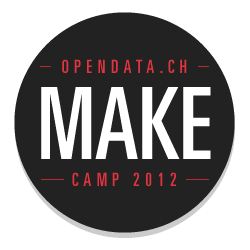
The Liipers present at the hackdays got involved in some of the projects:
Zurich: The Swiss Public Transport API
Team: Colin Frei, Danilo Bargen, Dominic Lüchinger, Fabian Vogler, Roland Schilter
Following our internal Transport API hackday in the beginning of the year, some others joined us to continue working on the Rest-API. The goal of the project was to provide a public transport Rest-API that allows every interested developer to create his own applications based on public transport schedules. Basically the API transforms the complex SBB XML response into a JSON format. Documentation and examples can be found at transport.opendata.ch.
During the two days, the team including three Liipers reacted on user requests and implemented new features to the existing API. Besides little changes, we added a location-based station search as well as the output of the full stage details.
Today, the API is already in use by several projects, including a command line interface and a wheelchair map.
Feel free to use it, extend it, and share it. Feedback is welcome as well.
Zurich: Transport Flows visualization
Team: Benjamin Wiederkehr, Dagmar Muth, Ilya Boyandin, Joel Bez, Patrick Stählin, Patrick Zahnd, Sylke Gruhnwald, Thomas Preusse
In the second project Patrick got involved in visualizing Transport Flows. Adapting the idea of the Villevivante project, the goal was to visualize the Swiss transport flows nicely and in an interactive way.
We collected the data based on the swisstrains.ch JSON output and processed it with Python scripts. With the given information, we created some interactive graphics using the JavaScript visualization framework d3. It turned out that it just perfectly matched our requirements and provided a wide range of features.
In the end we were able to visualize facts like sector-based train speeds and counts. We also visualized the transport hubs on a minute and hour basis.
An interesting statistic is the transport hub list, especially that Lucerne is the number three after Zurich and Berne. Also interesting is that the fastest railway line is still the “Bahn2000” between Berne and Zurich, which some of us use regularly.
The result can be found on flows.transport.opendata.ch.
Geneva: SiesteApp
Team: Andreas Kuendig, Benoît Pointet, Raphaël Halloran
The Geneva hackday crowd grew many interests which were more focused on the Geneva region, since a delegation of the territorial information systems department of Geneva (SITG) was present and provided great help and insights in the available geo-informations for the city. Topics like “bike mobility” or “multi-modality” got under heavy scrutiny, discussion and ideation.
Benoît got involved in a team who focused on a vague but non-the-less fascinating topic around individuality, emotions and comfort. He ended up working on a mobile app to help people find out where they could take a nap in Geneva; have a rest or just breath some fresh air in a quiet (or even dog-free) environment.
Follow the project at make.opendata.ch/doku.php.
Conclusion
Not only in the eyes of the Liip attendees the hackday was a success, but also in those of the participants and of the many institutional delegations visiting the hackday, like the SBB participants, who were impressed and willing to support the Swiss public transport API.
– Andreas Amsler, Benoît Pointet, Colin Frei, Fabian Vogler, Patrick Zahnd, Roland Schilter
